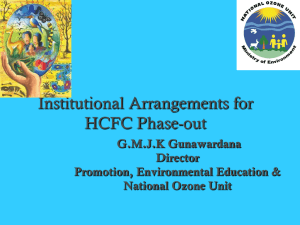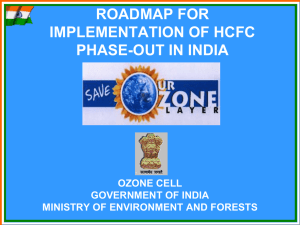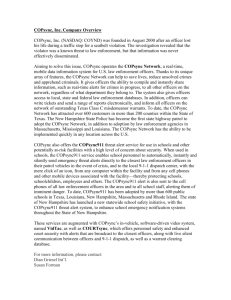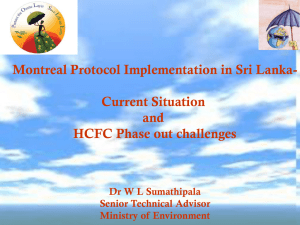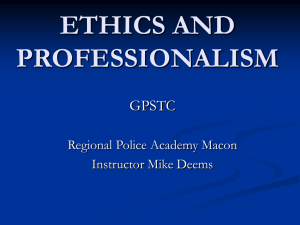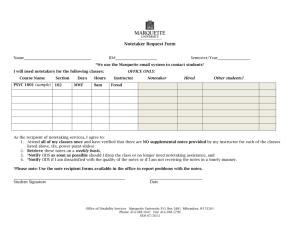Annex D.6
advertisement
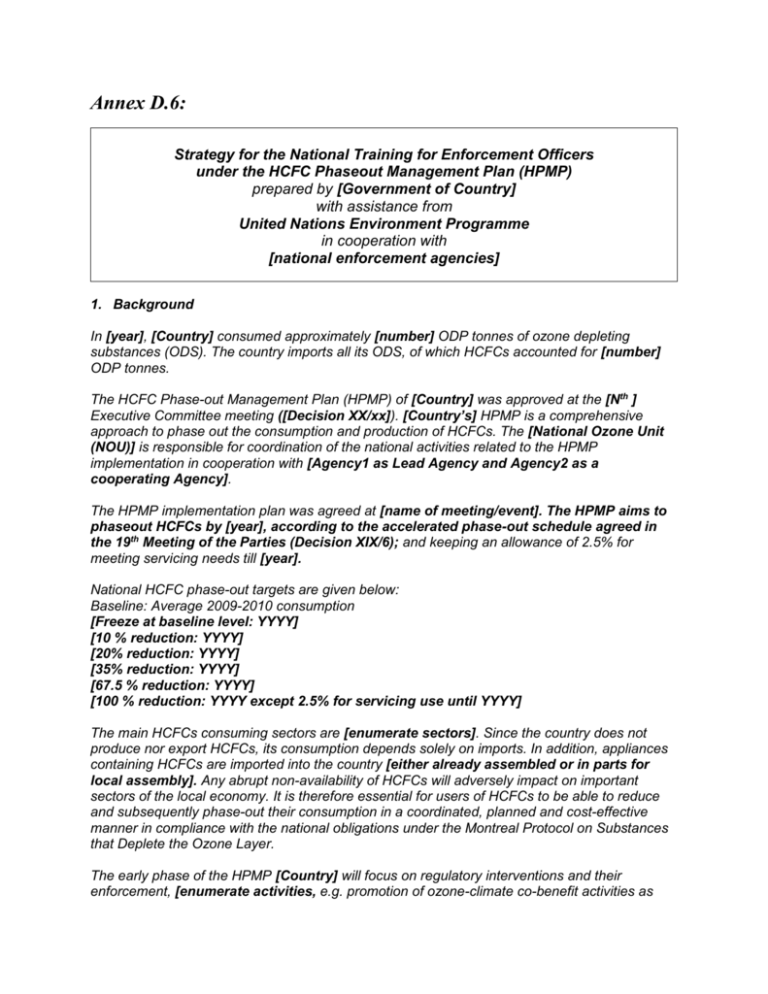
Annex D.6: Strategy for the National Training for Enforcement Officers under the HCFC Phaseout Management Plan (HPMP) prepared by [Government of Country] with assistance from United Nations Environment Programme in cooperation with [national enforcement agencies] 1. Background In [year], [Country] consumed approximately [number] ODP tonnes of ozone depleting substances (ODS). The country imports all its ODS, of which HCFCs accounted for [number] ODP tonnes. The HCFC Phase-out Management Plan (HPMP) of [Country] was approved at the [Nth ] Executive Committee meeting ([Decision XX/xx]). [Country’s] HPMP is a comprehensive approach to phase out the consumption and production of HCFCs. The [National Ozone Unit (NOU)] is responsible for coordination of the national activities related to the HPMP implementation in cooperation with [Agency1 as Lead Agency and Agency2 as a cooperating Agency]. The HPMP implementation plan was agreed at [name of meeting/event]. The HPMP aims to phaseout HCFCs by [year], according to the accelerated phase-out schedule agreed in the 19th Meeting of the Parties (Decision XIX/6); and keeping an allowance of 2.5% for meeting servicing needs till [year]. National HCFC phase-out targets are given below: Baseline: Average 2009-2010 consumption [Freeze at baseline level: YYYY] [10 % reduction: YYYY] [20% reduction: YYYY] [35% reduction: YYYY] [67.5 % reduction: YYYY] [100 % reduction: YYYY except 2.5% for servicing use until YYYY] The main HCFCs consuming sectors are [enumerate sectors]. Since the country does not produce nor export HCFCs, its consumption depends solely on imports. In addition, appliances containing HCFCs are imported into the country [either already assembled or in parts for local assembly]. Any abrupt non-availability of HCFCs will adversely impact on important sectors of the local economy. It is therefore essential for users of HCFCs to be able to reduce and subsequently phase-out their consumption in a coordinated, planned and cost-effective manner in compliance with the national obligations under the Montreal Protocol on Substances that Deplete the Ozone Layer. The early phase of the HPMP [Country] will focus on regulatory interventions and their enforcement, [enumerate activities, e.g. promotion of ozone-climate co-benefit activities as well as enhanced awareness activities and initiation of investment projects while the later phase will focus on a combination of non-investment and investment activities]. The country introduced its ODS import/export licensing system in [Month Year] and started implementation of its HCFC import/export licensing and quota system [since YYYY]. [Government Agency(ies), along with the NOU] are the agencies responsible for the management of the licensing and quota systems. The ability of front-line officers in key enforcement agencies including the customs to enforce the above mentioned regulations concerning ODS, ODS-dependent equipment and products containing ODSs is a vital element in national effort for HCFC phase-out (see Section 4 for a complete list of beneficiaries). 2. Goal and Objectives The overall goal of the enforcement training is for the country to acquire strengthened and sustained capacity to monitor and control trade in HCFCs effectively and efficiently during the HPMP implementation and beyond. The objectives of the enforcement training during the period [YYYY-YYYY] are primarily to: [Modify as appropriate] a. Inform enforcement officers about national regulations concerning HCFCs and the roles of enforcement officers in their application. b. Make enforcement officers aware about customs regulations and monitoring and control systems for ODS control in neighboring countries and in major trade partner countries. c. Familiarize enforcement officers with: international and domestic flows of HCFCs production and consumption; types of HCFCs and HCFC blends, HCFC-containing products and HCFCdependent equipment used in the country; domestic sectors with demands for those products and equipment, and alternatives to HCFCs. d. Equip enforcement officers with information and skills needed to identify, register, and handle HCFCs, HCFC blends, HCFC-containing products and HCFC-dependent equipment in accurate and safe manner in line with national laws and regulations. e. Identify ways to detect and prevent, whenever possible, illegal entry of prohibited ODSs in coordination with the [NOU]. f. Develop a national scheme for long-term and self-sustaining training to maintain a high proportion of trained personnel among the enforcement workforce during the entire period of the HCFC phase-out. g. Establish a network of ODS focal points in the country among enforcement agencies that are well linked with the [NOU]. As secondary objectives, the training could also be designed to familiarize enforcement officers with other Multilateral Environmental Agreements (MEA) with trade obligations and to create awareness about the HPMP and its linkages with the carbon neutrality plan of the country. 3. Methodology and Tools The training will be implemented in the following four steps: Step I: Institutional Set-up (2-3 months) [NOU] is to update the senior management of [Ministry or Gov’t Agency] about the overall legal frame for the Montreal Protocol implementation in the country and new regulations aimed to start the control and phase-out of HCFCs. The licensing system [with quota] for HCFC control is [put in place or updated] during this period. [Ministry or Gov’t Agency] in return is to update the [NOU] about the plan on the national adaptation of [HS2012] codes relating to HCFCs [(NB: if country uses ASYCUDA )in their ASYCUDA system, which is the automated system for customs data currently being used in the major customs stations of the country, to set up automated alerts on import of HCFCs]. Bilateral meetings are then to be carried out between [the NOU and Ministry or Gov’t Agency] to develop a detailed plan for the training and the responsibility to be assigned to each agency. Also during this step, baseline information on the existing knowledge and capacity related to ODS monitoring and control should be collected using some of the indicators proposed in Step IV. Step II: Preparation for National-level Training (4-6 months, including formulation of a draft national curriculum) A technical team comprising officers representing the [NOU, Ministry or Gov’t Agency, and the Customs training centre/institute] will be established to prepare a draft national curriculum for the training. The activities planned as part of the HPMP implementation will be used as an opportunity to pilot test the curriculum as well as to establish an institutional mechanism to maintain it. Tasks in this step include: a) Gathering and reviewing the existing training materials in the [NOU and Ministry or Gov’t Agency] and the additional material to be provided by UNEP as well as the joint WCO-UNEP e-learning course, “The Montreal Protocol: Phasing Out Ozone Depleting Substances” (http://www.wcoomd.org; http://learning.wcoomd.org1). a) Preparation of a "National Handbook on ODS Legislation and Import / Export Licensing System" and/or a “Desk book for Customs Officers2.” b) Identification of geographic locations (e.g. border areas) / offices that are critical for the enforcement of ODS laws and regulations. 1 Access to the online course by NOUs and non-WCO member customs officers has been facilitated by WCO and UNEP since 2011. For more information, please contact OzonAction CAP team in your region. 2 The model outline for “Desk book for Customs Officers” is available in Chapter 8 of the UNEP training manual "Training Manual for Customs Officers - Saving the Ozone Layer: Phasing out ODS in developing countries.” (Third Edition) c) Selecting and making necessary institutional / contractual arrangements for individuals who will take part in the regional Train-the-Trainers workshop(s) to be organized by UNEP (if any) and who will lead the implementation of the national-level training. d) [Appointment of a pool of resource persons to facilitate the national level and local level trainings]. e) Drafting of a curriculum to be implemented by [the Custom training centre/institute]. f) Designing and delivery of a national-level Train-the-Trainers workshop. [Ministry or Gov’t Agency] will provide all necessary training facilities and other logistical support as well as invite officers to the workshop. During the national Train-the-Trainers workshop, the trainees are to revise collectively and finalise the draft national training schedule and the material for training that have been generated at the regional workshop. Also, this national workshop will provide the opportunity to select a few outstanding officers who will join the nationwide training as a trainer. Step III: National and Local training workshops (up to 24 months) As per the institutional arrangements made during Step I and based on the preparation done during Step II, training will be delivered to enforcement officers. To reach a maximum number of officers in a cost-effective and sustainable manner in order to produce the most impact on control of HCFCs, the training shall make use of the following training methods in particular: Completion of online course(s) as a requirement prior to a face-to-face training3. Linking of HCFCs training with training organised by enforcement agencies such as [national training on HS2012]4. Case studies on actual schemes for unauthorised trade, smuggling, and use of HCFCs, HCFC mixtures, HCFC-dependent equipment and HCFC-containing products. An evaluation to test trainees’ level of knowledge at the beginning and at the end of the workshop. Group/break-out session(s) to discuss specific topic(s) and a reporting-back of key findings and recommendations from the group work. A practical, hands-on session on identifying HCFCs by examining packaging and labels as well as with the use of a digital refrigerant identifier. The face-to-face workshops will be made as interactive as possible, using case studies, quizzes, and group sessions to draw out conclusions and recommendations. Arrangements 3 It is recommended to make the completion of one e-course as a mandatory requirement in order to participate in a face-to-face training. 4 Model material to add a half-day or a full-day session on HCFCs to a national HS2012 training is available from The regional OzonAction CAP Team upon request. should be made to issue a “Certificate of Participation” for both the online course and the faceto-face workshop. Step IV: Review of the training programme (3-6 months) The [NOU] is responsible for the overall coordination and monitoring of the training as part of their mandate for the HPMP implementation. After completion of Step 3 above, the [NOU] will evaluate the results of the training and report it to national partners and to the Implementing Agencies of the HPMP. In the evaluation, it is recommendable to consider using indicators of success such as the following: Number/percentage of workforce overall and in front-line trained in HCFC monitoring and control. Number of advanced or specialised workshops held with help from the [NoU]. Number of trainers who are capable of offering basic training on HCFC control. Number of workshops held independently of the [NoU]. Upon completing all training workshops in Step 3, [Ministry or Gov’t Agency and the Custom training centre/institute] will re-visit the draft curriculum prepared during Step I to produce a definitive version of the training to be implemented by national partners on self-financing basis. In addition, the [NOU, Ministry or Gov’t Agency and the Custom training centre/institute] will agree on a way to enable continued, government-funded capacity-building for the trainers. One day or a half-day basic training on the Montreal Protocol should be made as part of the official curriculum of the national entity for enforcement training (e.g. Customs centre, college or academy) or as part of mandatory on-the-job training if the country does not have such institution so that it will be mandatory for all frontline and management-level officers to have basic knowledge about ODS control. The following materials are available for national training5: 5 UNEP (2012; in press). Training Manual for Customs Officers (3rd edition) - Saving the Ozone Layer: Phasing Out Ozone Depleting Substances in Developing Countries; and associated presentation material WCO-UNEP e-Learning Course on the MP Customs Quick Tool Green Customs Quiz UNEP CAP Factsheet Nos. 2, 11, 15, 16, 25, and 31 (prepared by ROAP) HPMP implementation plans in your Region (including list of NOOs) ODS Concealment Guide by Interpol EIA video and factsheets Material from projects and partners See also Chapter 8 of the "Training Manual for Customs Officers - Saving the Ozone Layer: Phasing out ODS in developing countries.” (Third Edition) NB: Do not hesitate to coordinate with your Regional CAP team for the latest and additional training tools and materials. 4. Expected Results (Outcomes) When it is completed successfully, the training should enable enforcement officers to internalize the knowledge and to exercise the capacity gained to enforce laws and regulations concerning HCFCs. More specifically, the training should produce the following outcomes: [Modify as appropriate] The officers – both new and experienced – should be given periodic opportunities to refresh skills and obtain additional information concerning HCFCs and the Montreal Protocol in general as part of their institutional training programmes. By Year [YYYY], the training would become an integrated part of the national training curriculum that is mandatory for all customs officers, funded by the Customs. National licensing and quota systems for HCFCs are enforced and effective, thus supporting the country’s compliance with national ozone protection regulations and the Montreal Protocol. Trade in HCFCs, HCFC blends, HCFC-containing products, and HCFC-based equipment are registered accurately using the latest customs codes [HS2012 and national sub-coding]. Customs trade registry on ODSs and ODS-based equipment is cross-checked with data of the ODS licensing system at least every [number] months until Year [YYYY], and subsequently would be checked every year during [specify]. Refined and optimized operational details of HCFCs monitoring and control are well and widely understood by enforcement officers. Tools for ODS identification, for monitoring and controlling of trade in ODS, and for continued learning are accessible to and widely used by enforcement officers. Registration and initial use by the participating officers of the WCO-UNEP online customs training module on the Montreal Protocol. The country uses the informal Prior Informed Consent (iPIC) mechanism actively as an additional channel for screening unwanted trade in ODS. The country is engaged actively in international/ border areas cooperation to combat illegal trade in HCFCs, HCFC blends, HCFC-containing products, and HCFC-dependent equipment. In addition, using its experience in enforcement of trade obligations under the Montreal Protocol, the enforcement agencies in the country should be capable of becoming an active player in national efforts to fulfill trade related obligations under other Multilateral Environmental Agreements (MEAs). With newly gained or reinforced knowledge on MEA enforcement, enforcement agencies and their officers should be able to promote mainstreaming of environmental issues into ongoing bilateral trade cooperation mechanisms, border dialogues, and/or national effort to combat Transnational Organized Crime (TOC). 5. Beneficiaries Beneficiaries of the enforcement training under the HPMP are to be drawn from the following groups and organizations: [Modify as appropriate] Trainers from the Customs training unit Customs officers from various ports of entry, check points, and customs sections (computer and data processing, classification, administration, enforcement, investigation, risk management) Enforcement officers from police, coast guard, Defense Force Central/ National Laboratory Ozone officer of the NOU Attorney General’s Office Local refrigeration expert to support practical session Private sector representatives including importers, customs brokers, wholesalers Ministry of trade and economic development Ministry of Fisheries and Agriculture Ministry of Tourism and Culture Ministry of Environment/ Environmental Protection Agency Prosecutor General’s Office Media and general public (during opening, closing and awareness sessions)] It has been proven beneficial to involve the Customs administration of the country with which much of the ODS is traded. If resources permit and national stakeholders agree, they can be invited to take part in selected activities; e.g. training, during the implementation of the enforcement strategy. 6. Activities and Expected Outputs The enforcement training is comprised of both virtual6 and presential (face-to-face) activities. As part of the HPMP of [country], the following activities are to be carried out: [Modify as appropriate] Activity One-day Stakeholder consultation workshop to discuss the draft regulations (after formulation of the draft (3040 participants) x 2 Law enforcement officers training workshop on new regulations, 8 workshops Procurement of ODS Identifiers (10 sets) 6 Timetable 2010-2015 Budget (US$) ---- 2010-2020 ---- 2010-2013 ---- Use of the WCO-UNEP online customs training module on the Montreal Protocol is recommended.
